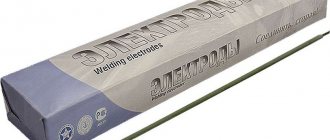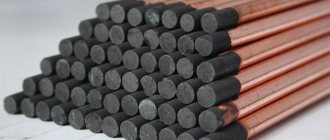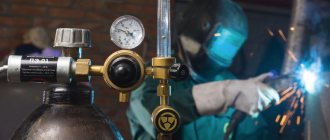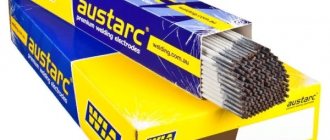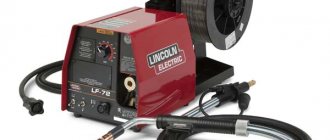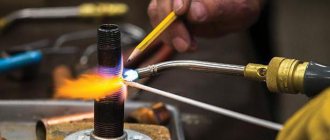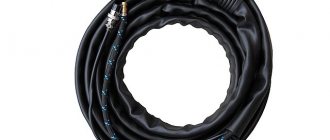Home / Electrodes
Back
Reading time: 2 min
0
2720
OZL-6 electrodes are the most famous brand among professional welders. They are versatile and easy to use. These advantages make them indispensable both in large enterprises and when independently welding steel.
The article will discuss those characteristics of OZL-6 rods that made them convenient for a variety of welding jobs. We will tell you why professionals choose this brand and in what areas it is used.
In addition, you can find out what analogues of OZL-6 are in our stores.
- GENERAL INFORMATION
- APPLICATION AREA
- FEATURES AND ANALOGUES
- INSTEAD OF CONCLUSION
general information
In the manufacture of the rod, alloyed wire SV07X25N13 is used. Therefore, during welding, it is preferable to use DC machines with reverse polarity.
Reliable protection of the weld pool is guaranteed by the base coating.
Another advantage was the ability to obtain a high-quality seam in any spatial position.
Explanation of markings
Electrodes of this brand were developed in, and the marking gives the following information:
- OZL – ash main coating type;
- 6 – purpose of the manufactured seam.
Electrodes OZL-6.
Classification and GOST
Russian enterprises producing such products operate in accordance with GOST 10052-75 “Coated metal electrodes for manual arc welding of high-alloy steels with special properties.”
Generally accepted product qualifications:
- welding electrodes OZL-6-2;
- OZL-6-2.5;
- OZL-6-3;
- OZL-6-4;
- OZL-6-5.
Where are OZL-6 used?
Due to their characteristics, such consumables are used when it is necessary to make seams and connections of low-carbon steels, metals with a low content of alloying additives, heat-resistant alloys, cast and rolled structures installed in places with an aggressive environment. Performance characteristics are maintained at temperatures up to + 1000 °C.
Welding modes
The method of working with electrodes is presented in the table:
| Electrode diameter | Current strength when welding in the lower position, A | Current strength when welding in a vertical position, A | Current strength when welding in the ceiling position, A |
| 2 | 40-55 | 30-40 | No |
| 2,5 | 50-70 | 40-60 | No |
| 3 | 60-80 | 50-70 | No |
| 4 | 120-140 | 100-120 | 100-110 |
| 5 | 140-160 | 120-140 | No |
For what metal: stainless steel and not only, areas of application, purpose
Electrodes of the OZL brand are used mainly by professional welders in the construction of metal structures with increased requirements for the corrosion resistance of welds to increase the reliability of the structure. In addition, the welding seam of such electrodes has the qualities of heat resistance and heat resistance , which allows these objects to be operated at elevated temperatures without fear of destruction.
In the energy, food, chemical, oil and gas industries, parts operating in aggressive environments made of stainless alloys, welded using OZL electrodes, are successfully used. Some types of such consumables, on the contrary, are used in structures where it is necessary to ensure the cold resistance of the welding joint.
Sometimes it becomes necessary to weld carbon or low-alloy steels with high-alloy steels. Among the brands of OZL consumables you can find those that will perform such welding efficiently.
Specifications
The use of OZL-6 is associated with their technical characteristics:
| Characteristic name | Data or description |
| Arc burning | Sustainable |
| Metal spatter level | Small |
| Formation of the resulting seam | good |
| Separability of slag crust | Satisfactory |
| Deposition coefficient (in the lower position of the seam) | 10.0 – 13.0 g/Ah |
| Deposition performance (for 4.0 mm diameter) | 1.1-1.7 kg/h |
| Consumption per 1 kg of deposited metal | 1.6 kg |
| The tendency of the weld metal to form pores | Prone to poor preparation of the joint and lengthening of the welding arc |
We recommend reading Technical characteristics of MP-3 electrodes
Size range
The most popular types of welding consumables of this brand are sold on the market:
- for operation with current from 60 to 130 A, diameter 3 mm and length 350 mm – 30 pcs. in 1 kg;
- for operation with current from 100 to 2100 A, with a diameter of 4 mm and a length of 450 mm - 15 pcs. in 1 kg;
- for work with current from 150 to 280 A, with a diameter of 5 mm and a length of 450 mm - 10 pieces per 1 kg.
Electrodes diameter 4.0.
Chemical composition of OZL-6 electrodes
The properties of consumables are ensured by the chemical composition of the coating, consisting of the following components:
- Carbon in an amount of 0.09%, which binds free metal molecules and gives it strength. Due to the precisely adjusted percentage, a solid connection is obtained that eliminates brittleness.
- Manganese – 1.9%. It plays a similar role, and also promotes the removal of sulfur and phosphorus. The resulting seam is smoother and more uniform, resistant to mechanical stress.
- Silicon – 0.38%, which is a deoxidizing agent. It removes free oxygen from steel, helping to reduce chemical segregation and improve mechanical properties, increasing ductility and strength.
- Nickel – 12.8% for oxidation resistance and increased heat resistance of the joint. Physical properties are maintained in corrosive environments.
- Chromium – 24.9%. It becomes an alloying component and reduces abrasive wear, the tendency to rust and improves the quality of the joint after thermal loads.
- Sulfur (0.011%) and phosphorus (0.022%) entering the main layer from the charge and alloys during manufacturing. Their number was minimized and the number of cracks during welding was reduced.
Properties of the resulting seam
The metal connection obtained by welding with OZL-6 electrodes has the following mechanical characteristics:
- temporary resistance 560 MPa;
- relative elongation by 25%;
- impact strength 90 J/cm²;
- ferrite phase 6.1%.
We recommend reading Which aluminum electrodes to choose
Weld.
Features of surfacing
A negative feature of these consumables was the high consumption during welding. Creating a fixed length seam will require 60% more electrodes compared to other brands.
Therefore, to increase efficiency, it is necessary to prevent sticking or boiling of the rod and splashing of metal around the workplace.
To do this you need to do the following:
- calcinate the electrodes before starting to join metals for 1 hour at a temperature of +180-200°C;
- do not work in a vertical plane;
- clean the tip of the rod;
- carefully sand the surfaces to be welded;
- conduct an arc spark along the top of the seam at an angle of 80° and at a distance from the joined edges of no more than 3 mm;
- follow the welding mode, focusing on the instructions printed on the packaging;
- after replacing the electrode, you need to clean the joint and continue welding from a point located slightly higher from the stopping point;
- Do not allow the seam to cool suddenly.
Metal stripping.
Useful tips
In order for welding of stainless steel parts to take place without any difficulties, during work you should take into account the recommendations from professionals:
- If during welding work the temperature rises to +500 degrees Celsius or higher, then it is quite possible that crystallization-type cracks will appear at the site of the future weld. This should not be allowed, otherwise the connection will be less strong and reliable.
- When welding stainless steel parts at temperatures from +350 to +500 degrees Celsius, the alloy becomes less ductile, and this can make the metal more brittle.
- To create a high-quality weld, stainless steel parts prepared for joining must be heated to a temperature of +1200 degrees, and then cooled naturally. They need to cool for at least 3 hours.
- The welding seam is as strong and reliable as possible when welding takes place in the shortest possible time. Prolonged heating of stainless steel products should be avoided. When using the layer-by-layer welding method, a new layer is applied only when the previous one has cooled to +100 degrees.
- Sometimes before applying the base layer you have to tack two blanks. In this case, you need to make sure that the gap between them is as small as possible. You should strive to ensure that the potholders are as long as possible.
https://youtube.com/watch?v=Zngv3j_zH4g
The best manufacturers of OZL-6 electrodes
Currently, these electrodes are manufactured at the following Russian enterprises:
- "SpetsElectrod" is a leading Russian enterprise in the industry with more than 70 years of experience in the production and development of welding equipment. The plant's products have been awarded numerous diplomas for quality, confirmed by the standards of Russia, Belarus, Ukraine and Kazakhstan. The electrodes have received approval from the Russian River and Sea Shipping Register. NAKS, Gosatomnadzor.
- Frunze-Electrode is a Ukrainian plant operating since 1930 and part of PJSC Sumy NPO. Swiss equipment produces more than 170 types of welding consumables. The products are certified according to ISO 9001:2008 Bureau Veritas Certification No. IA 226095 and UkrSEPRO No. IA2.021.04709-10 and are supplied to leading enterprises in Ukraine,
- "Ecom-Plus", a Ukrainian enterprise that appeared in 2002. The founder was S.M. Kiselev, who previously worked at the IES named after. E.O. Paton. In 2014, reconstruction began, and a year later a new production facility opened on the German line of the Kjellberg Finsterwalde company.
Brand of electrodes Frunze-electrode.
Electrode brand SpetsElektrod.
Electrodes brand EconomyPlus.
Basic techniques and varieties
Using the correct stainless electrodes is the main, but not the only requirement for working with this type of steel. The overall dimensions and thickness of the workpiece, as well as the welding equipment used, play an important role. Let's look at the main features.
Variable or constant
There are no restrictions related to polarity in the technical documentation, therefore it is permissible to use a current that is convenient for the welder. Each type has its own advantages and disadvantages.
With constant current, there is virtually no melt spatter, which reduces core consumption and increases productivity and quality. However, devices of this type are highly expensive, which narrows the range of their use.
Large enterprises use only direct current.
Reverse-type units are much cheaper, but the consumption of electrodes, due to strong splashing, will be higher.
For DC
The most commonly used are the rods that were discussed above:
- OZL-6,
- TsL-11,
- NZh-13.
If possible, it is better to use foreign OK stainless steel electrodes produced by ESAB.
For AC
Inverters belong to the budget class of welding equipment. Accordingly, consumables are of lower quality and affordable. These include:
- EA-400,
- OZL-14,
- LEZ-8,
- TsT-50,
- N-48.
For stainless steels and ferrous metals
The connection of dissimilar elements is carried out with special transition electrodes from stainless steel to ferrous metal. It is allowed to use both flux-coated rods and devices operating in a protective gas environment. The following types are used as consumables:
- OZL-312. The universal composition allows you to work with workpieces made from materials that cannot be identified.
- EA-395/9. Used for more critical stainless steel components.
What to cook 1 mm?
Thin elements are the most difficult type from the point of view of welding technologies.
This is due to the following factors: The intense thermal effect of the electric arc can cut the surface or lead to disruption of the integrity of the plane. Moving the short arc must be done with special attention - the slightest deviation of the hand will extinguish it.
To facilitate the process, experienced specialists recommend using ESAB electrodes. They are designated by the abbreviation OK. The best choice would be OK 63.34 - it is distinguished by its versatility.
For thin-walled structures, preference should be given to OK 63.20.
Is it possible to weld steel?
There are no direct prohibitions on such activities, however, it was experimentally established that when welding steel with stainless steel rods, corrosion began to actively develop in the area around the seam. It is noteworthy that the seam itself does not suffer at all.
High-quality analogues
Products with characteristics similar to OZL-6 are produced by the following foreign enterprises:
- BÖHLER, Austria, specializing primarily in the production of high-quality steel grades. A separate division also produces consumables for welding. Electrodes FOX CN 23/12-A became an analogue.
- OERLICON, USA with models INOX 25/14, VERTINOX 309 Mo, FERINOX. Since 2022 he has been working in Moscow and Skolkovo. Customers for welding components include enterprises in the automotive, aerospace, energy, and oil and gas industries.
- LINCOLN, USA, offering a wide range of welding equipment for industry and home use. As a replacement for OZL-6, it produces electrodes marked Arosta 309S, Limarosta 309S, Arosta 309Nb, Arosta 309Mo,
- UTP, Germany - has been operating since 1953 under the name Handelsgesellschaft Universal Tiefpunkt GmbH. The phrase universal tiefpunkt is translated as the common “lower” melting point of metals in a eutectic alloy. Since 1956, the production of welding materials began in Switzerland, since 1993 - in Mexico, since 1969 - in Brazil. The brand was later purchased by the Böhler Welding Group. As a substitute for ash electrodes, UTP 6824, 6824 LC, 6824 MoLC, 6824 Nb, 6824 MoNb products are produced.
- ESAB, Sweden - the history began with the receipt in 1904 of a patent for a coated electrode for electric arc welding, which was received by company founder Oscar Kjellberg. His initials still adorn the concern’s products. Companies producing welding equipment operate all over the world, incl. in Russia, Belarus and Kazakhstan. Analogs to OZL-6 were OK 67.62 and OK 67.60.
- KOBE STEEL ltd., Japan - the largest supplier of materials and equipment, owner of the KOBELCO brand. Welding materials have been produced for over 60 years. As a replacement, the range includes electrodes NC39, HIMELT 309, NCA-309, NC-39L, HIMELT-309L,
Seams made by foreign analogues do not differ in quality from those welded with domestic OZL-6 electrodes.
Properties of stainless steel
Corrosion resistance has a downside - the presence of alloying additives complicates the welding process, which is expressed in the following characteristics:
Low thermal conductivity makes it difficult to remove heat from the heat-affected zone. You need to cook stainless steel with reduced amperage characteristics. The current strength should be 15-20% less compared to welding ferrous metals. When working with thin-walled products, the thickness of which is less than 2 mm, special copper plates are placed under the seam. They prevent leaks and remove excess thermal energy. When connecting thick workpieces, it is necessary to leave a large gap. Otherwise, microscopic cracks will form around the seam, negatively affecting the strength of the joint. Stainless steel has high electrical resistance. Under the influence of an electric arc, welding rods are exposed to strong temperatures. For this reason, universal-purpose electrodes are not suitable for working with metal.
When choosing consumables, you should pay attention to the packaging labeling.
Some welding work and difficulties
Below are some types of work that involve welding stainless steel, and an overview of the problems that may arise.
Pipe welding
A stainless steel pipe runs from the boiler to the expansion tank. Usually it is connected using an American pipe, however, if there is a complex pipe system, you will have to cook it a little, and you will have to do the welding itself to the boiler. Welder-plumber is a complex and extensive specialty that takes a long time to learn. You will have to weld in any position, and also think ahead about how to cut the pipe, in what sequence to weld the bend or perform other work.
Brew the muffler
Typically mufflers are made from ordinary steel. However, you can also buy stainless steel ones on sale. They perform well and last longer. During operation, the muffler is removed from the car, cleaned and repaired using patches. Thin-walled steel is placed on it, and cooking with an electrode here is pure masochism. Semi-automatic to the rescue.
Welding with inverter
Suitable for the same applications as DC welding. In this case, the polarity of switching on the holder is maintained. Typically, such welding will be slightly worse in quality than with a professional straightener. But if you consider that the rectifier weighs one hundred to two hundred kilograms, and the inverter weighs no more than twenty, then the choice will be in favor of the latter.
It is advisable to purchase an inverter that can be connected to a three-phase outlet. Two phases are usually not capable of providing such a current strength at which the metal will be well welded using similar methods.
Moreover, you should not include an inverter for welding stainless steel in the home network - eight-amp plugs are only enough for welding with ANO-24 electrodes. In general, working with the inverter is convenient; there is a system for auto-ignition and arc stabilization using automatic current regulation.
Features of stainless steel
Unlike a number of other popular metals, stainless steel has a number of features that can appear when connecting elements from this metal. All this must be taken into account when starting to manufacture various structures and products from this material. Compared to many other types of steel, stainless steel has lower thermal conductivity. Because of this, you have to spend more time warming up the welding zone or use a higher current for work.
When welding elements of fairly large thickness made of stainless steel, the gap between them should be slightly larger than when connecting elements made of other types of steel. This is the only way to minimize the number of microcracks that may appear after welding.
When joining stainless steel elements by welding, the welding rods are heated to very high temperatures. This happens due to the fact that the metal has high resistance to welding processes. To reduce this manifestation, experts recommend using special electrodes designed for stainless steel for welding.
